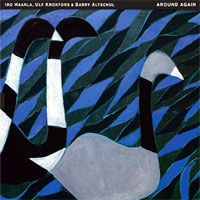Iro Haarla, Ulf Krokfors & Barry Altschul • Around Again: The Music of Carla Bley
 hen Iro Haarla first encountered Carla Bley scores decades ago,
the Finnish pianist couldn’t fathom how to improvise on them. They were so
elliptical, sketchy even. Then Haarla heard pianist Paul Bley play some on records from
the 1960s, and all became clear. So this set of Carla’s compositions is really a
double homage: to the composer and to her onetime husband Paul who'd encouraged her
writing and first showcased her tunes. Most of the dozen pieces on Around Again
(written between 1961 and 1980) were premiered by Paul’s trios. His frequent drummer,
from the mid-’60s on, was Barry Altschul, who says in a liner note that on this
session, he instantly reverted to playing these tunes with the same floating time-feel
he’d deployed with Paul back when. As ever, Altschul buoys the group rhythm and is
very much a listening team player. hen Iro Haarla first encountered Carla Bley scores decades ago,
the Finnish pianist couldn’t fathom how to improvise on them. They were so
elliptical, sketchy even. Then Haarla heard pianist Paul Bley play some on records from
the 1960s, and all became clear. So this set of Carla’s compositions is really a
double homage: to the composer and to her onetime husband Paul who'd encouraged her
writing and first showcased her tunes. Most of the dozen pieces on Around Again
(written between 1961 and 1980) were premiered by Paul’s trios. His frequent drummer,
from the mid-’60s on, was Barry Altschul, who says in a liner note that on this
session, he instantly reverted to playing these tunes with the same floating time-feel
he’d deployed with Paul back when. As ever, Altschul buoys the group rhythm and is
very much a listening team player.
These days, finally, Carla Bley gets her due as composer. Her writing often betrays pithy wit; there’s an almost goofy, awkward quality to, say, the stumbling little march "King Korn." At other times her fold-in-on-themselves melodies are more poignant. Both varieties are conducive to improvisation. Players can paraphrase her shapely melodic kernels all kinds of ways, while preserving their recognizable contours. On her classic ballad "Ida Lupino," you can hear a through-line even as the basic figure (a repeated-note phrase with an upward ripple) evolves over the basic eight-bar sequence. Most of the melody sits on the white keys (it’s in C), but it disorients you, by starting on a thrice-repeated B. The tune was inspired, she once said, by doo-woppers the Four Seasons. Complications aside, her melodic sense is pop not bebop. Other compositions are more skeletal. The mini-fanfare "And Now the Queen" is four bars long but in three shifting time signatures, as Carla’s biographer Amy Beal reminds us in her liner note -- this disc is well annotated. "Batterie," in a sort of broken or free waltz time, has tricky start-and-stop momentum, but the lurching gives Altschul and bassist Ulf Krokfors angles to latch onto, and sets up the more loosely calibrated jam on the theme which follows. Bley’s durable melodies sell themselves; Haarla and company only have to connect the dots to sound good. The composer’s yearning harmonies keep the improvising on her catchy melodies from getting sing-songy. And melodic simplicity discourages over-decoration. You can hear how well Haarla grasps all that, on Bley’s peasant hymn "Jesus Maria," where the bassist tracks the piano from just far enough behind to avoid collisions, and Altschul dissolves into the background on brushes. Much as Haarla digs Paul Bley, she has her own ideas, and a darker piano sound, using sustain pedal to let harmonic clouds accumulate and disperse. She’s more a chordal than long-line melodic pianist. Haarla also plays the harp (though not here), and you may hear traces of harp technique where she sounds the notes of a chord in rapid succession, and lets successive chords fade (not that you need to play harp to think of that). Haarla and bassist Krokfors came up together in Finnish-jazz patriarch Edward Vesala’s band, and each hears where the other is headed, and gives room to get there. The bassist takes the first melody statement on "Olhos de Gato," accompanied by Altschul’s quasi-melodic mallets on skins. There are a couple of nods to one more Bley associate. On
"Ůtviklingssang" and the intro to "Vashkar," Krokfors reproduces the
plosive, rubbery bass sound and climbing simple-scalar lines of Charlie Haden, whose
Liberation Music Orchestra played Carla’s charts. The sonics help conjure the
specific timbre and attack of Haden’s amplified tone in the 1970s. Normally that
would not work to the music’s advantage -- the bass sound on ’70s records is
generally horrendous -- but here it serves a purpose. Krokfors has injected such Hadenisms
in other settings, but here it fits snugly into the program: a tribute album with a sense
of history. The bassist’s sound is a little slabby, but you can hear the wood in it,
and (like Altschul, sounding crisp) he isn’t mixed overly loud. The leader’s out
front and that’s okay, a perk of leadership. Not too much reverb either; pianists
have a foot pedal for that after all. |
